Technology continues to improve at a rapid pace. This week I will feature a couple of Australian startups. One that is improving Car Vision with a better LIDAR system and another that is improving Computer Vision. Both startups have entered competitive fields with a different way of solving the problem and it appears that both have succeeded. I will also have a quick look at the progress in Self Flying Cars. I know that you all want one.
Improving Self Driving Car Vision
Baraja is an Australian startup that has developed a better LIDAR (Light Detecting and Ranging) to improve the vision of self driving cars. Environmental sensing technology makes self-driving cars possible. Without the ability to sense the immediate area around a car, computer systems would have no way of knowing what speed to set, where to turn, when to change lines or when to apply the brakes. The sensing system must detect every possible movement within its range to make split-second life-saving decisions.
That is where LIDAR comes in. Most self driving cars use some form of LIDAR to detect the environment that the car is driving within. Tesla uses a camera system. LIDAR is a surveying method that measures distance to an object by illuminating the object with laser light and measuring the reflected light with a sensor. Differences in laser return times and wavelengths can then be used to make digital 3-D representations of the object.
Baraja LiDAR connects a wavelength-tuneable laser (“Engine”) to prism-like optics (“Sensorheads”) using fiber optic cable. When light reaches the optics, it is naturally deflected in different directions: no rotating lasers or moving mirrors required. By changing the color – or wavelength – of the laser, the system can scan different angles instantaneously, with unparalleled detail and adaptability. The system can provide pedestrian detection at 260 meters in highly complex urban environments. It can also detect objects as close as 0 cm away including dirt and insects on the car’s windows.

Click on the photo to see the system in action on Baraja’s site. Baraja is based in Sydney with offices in Shanghai and San Francisco.
Improving Computer Vision
Xailient is an Australian startup that is developing a faster, smaller Computer Vision. Why is this important? Xailient claims that their system reduces bandwidth, improves latency and saves on computation costs by 90%. Lower cost and faster speed will allow a much wider range of applications to be developed and implemented.
Computer Vision is an application of AI that allows computers to detect and recognize objects and events from an image. Applications include public safety & security surveillance, traffic analysis, retail analytics, intelligent baby monitors, drones and self-driving cars.
Xailient runs on a variety of IoT (Internet of Things) devices, processing data at the point of origin, reducing costs and the delay in transmission of data to a cloud or business based computer server. Additionally the software is trained to focus on the important information in an image. For example in Security Camera Footage the AI is trained to look for people but ignore cars, resulting in a 20 times improvement in performance.

Xailient is presenting their technology at the upcoming Antler Demo Day at the Sydney Town Hall on November 7. Tickets are available here.
Self Flying Cars
The movies all promised us flying cars. So where is my flying car? Not as far away as it might seem. There are a huge range of self flying cars being developed. The advantage of flying cars is that they don’t need to account for pedestrians, trees, cyclists and kangaroos (cyclists and kangaroos are two of the most difficult objects for self driving cars to deal with, they move at speed and are not fully predictable in their movement).
This week Boeing and Porsche announced that they are currently developing a concept VTOL (Vertical Takeoff and Landing) vehicle. It will be a Self Flying Electric Taxi. They’re joining a range of companies working on Self Flying Cars including Volvo, DeLorean (about time that reality caught up with Cinema, “Back to the Future” promised us this would be reality in 2010), Toyota (they hope to have their Self Flying Car demonstrated in Tokyo during next year’s Olympics), Uber, Airbus, Lilium (Germany), VRCO (British), Kitty Hawk (US), Aeromobile (Slovakia), PAL-V (Dutch), Terrafugia (spun out of MIT) and Joby Aviation (funded by Toyota and Intel). Some vehicles are designed as hybrids for the road and air, others are purely designed for flight.
Terrafugia (hybrid for land and air)

Joby

Toyota

PAL-V (hybrid for land and air)

The difficulty that Self Flying Cars will have is aviation legislation and approval to fly in cities. It is likely that approval will involve designated take off and landing points with fixed flying routes that reduce the impact of damage if there is an accident. For those that live in Sydney you may know that there is a virtual highway along the Parramatta River for helicopters to fly via when traveling from the City to Parramatta and beyond. Self Flying Cars will likely follow a similar path of fixed routes.
When will we see Self Flying Cars? That is difficult to predict. The wheels of Aviation approval move very slowly. PAL-V however are currently taking pre-orders in Holland. Order one here (from EUR300,000 plus taxes etc.).
Spark Festival 2019
This month the Spark Festival is on in Sydney. The Festival is Australia’s largest showcase event for startups, innovators and entrepreneurs. There is a huge range of presentations and demonstrations all over Sydney and beyond. With over 130 events, many free, there is something for everyone interested in the sector. The Full Program is available here.
Paying it Forward
If you have a start-up or know of a start-up that has a product, ready for market please let me know. I would be happy to have a look and give the start-up a shout out to my readers if it is something that I think they could use. If you have any questions or comments please email me via my website craigcarlyon.com
I would also appreciate it if you could forward this newsletter to anyone that you think might be interested.
Till next week.


